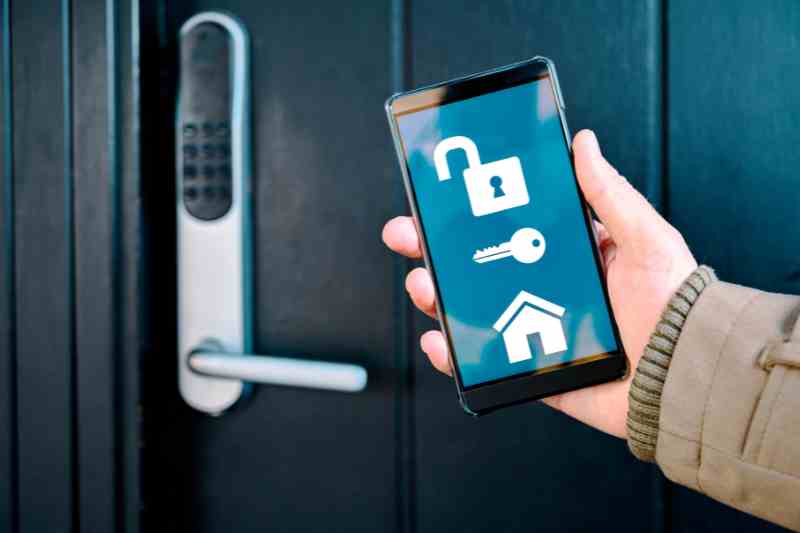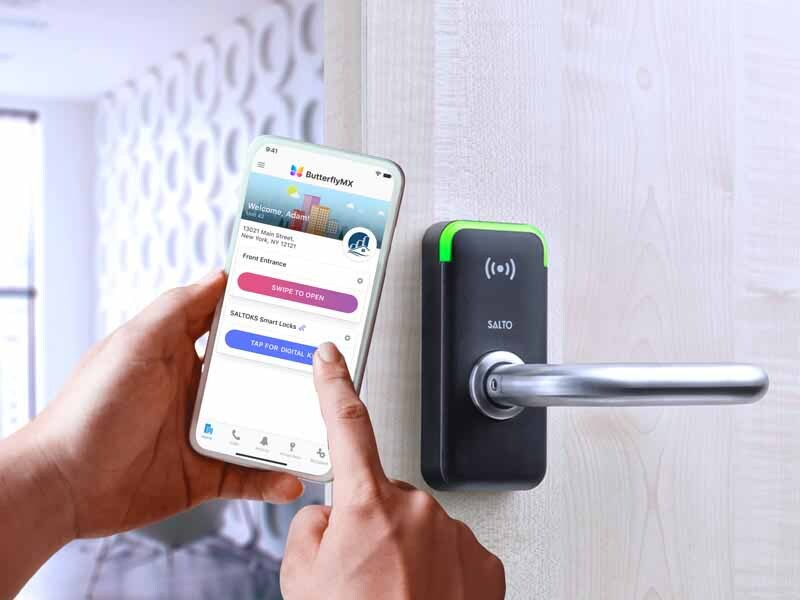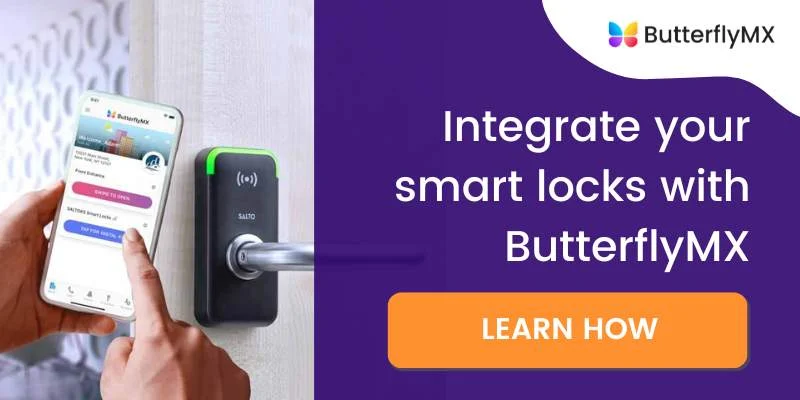Key takeaways
- Some of the best WiFi smart locks include August, Schlage Encode, and Yale Assure.
- WiFi, Bluetooth, and Z-Wave are the most common connectivity types used by smart locks.
- Choose a WiFi lock for affordability, convenience, and easy setup.
- Property managers and owners can integrate their smart locks with a property-wide access control solution, such as ButterflyMX.

You’ve likely seen the long list of smart locks on the market, ranging from Z-Wave to WiFi smart lock technology. But wading through the sheer number of products online can make it difficult to choose one.
For that reason, we list the best WiFi smart locks in this buyer’s guide. Additionally, you’ll discover the types of connectivity used, why you should choose WiFi locks, and how you can integrate them with other property technology.
In this post, you’ll discover:
- 5 best WiFi smart locks
- Types of connectivity in smart locks
- What to know before you buy WiFi locks
- Why choose WiFi smart locks?
- Integrating WiFi smart locks with other proptech
5 best WiFi smart locks
The best WiFI smart locks on the market include:
1. August WiFi Smart Lock
Cost: $199.99
Integrations: Amazon Alexa, Google Assistant, and Apple HomeKit
The August WiFi Smart Lock is the most popular WiFi-enabled smart lock on the market. Its compact design and ease of installation make it the go-to lock for many renters and homeowners.
Unlike other locks on this list, the August WiFi Smart Lock modifies the existing deadbolt to enable smart access. So, you don’t have to replace the entire lock, making it a great option for renters. Of course, homeowners and commercial properties will find a lot of value in August, too.
August Smart Lock features include:
- Auto-lock and unlocking.
- Your existing keys will still work.
- Unlock the door with your smartphone or Apple Watch.
- Mobile app includes an activity feed and smart notifications.
- Create Visitor Passes for guests to share access with family and friends.
- Optional keypad enables entry with a code.
2. Schlage Encode
Cost: $289
Integrations: Amazon Alexa, Google Assistant, and Ring
Available in a number of styles and finishes, the Schlage Encode is best suited for multifamily and single-family properties. With built-in WiFi, the Encode allows you to unlock and lock from anywhere. When paired with the Schlage Home app, you can provide temporary access to guests with no additional fees or hardware requirements.
Features of the Schlage Encode include:
- Manage up to 100 access codes for guests.
- Built-in alarm to warn of potential tampering or breaches.
- Low battery indicator weeks in advance.
- Supports traditional keys, PIN codes, and the mobile app for credentials.
3. Yale Assure Lock 2
Cost: $259.99
Integrations: Google Home, Amazon Alexa, Apple HomeKit, and SmartThings
The Yale Assure Lock 2 is a modern and sleek WiFi smart lock that’s designed for apartments, offices, and houses. Yale offers the Assure Lock 2 in multiple different styles and models. For example, you can choose from a Bluetooth or WiFi model based on your connectivity preferences. Not to mention, you could choose the Touch model that allows you to use your fingerprint to unlock the door.
Overall, the Yale Assure Lock 2 is packed with features:
- Available in keyed and key-free options.
- Provides real-time push notifications regarding the status of your lock.
- Choose between a touchscreen or keypad faceplate.
- Share or schedule digital keys for guests.
- Auto-unlock option.
4. Kwikset Halo
Cost: $199
Integrations: Amazon Alexa and Google Assistant
Kwikset’s Halo WiFi-enabled smart lock lets you control your property’s security from anywhere via the Kwikset mobile app. No additional hub or controller is needed to set up. Instead, all you need is to connect the Halo smart lock to the router. Then, you can start accessing your home with one of the three supported credentials: mobile app, PIN code, or key.
The Halo smart lock features:
- Customize user codes so they’re temporary or limited to certain times or days of the week.
- Track lock activity through the Kwikset mobile app.
- Receive push notifications when there is new activity on your lock.
- Manage multiple locks at multiple properties from one app.
- One-touch locking button
- Built-in alarm activates when three consecutive incorrect codes are entered.
5. Eufy Smart Lock C210
Cost: $99.99
Integrations: Amazon Alexa and Google Assistant
The Eufy Smart Lock C210 is the most affordable option on our list but includes a wide range of features that you’ll benefit from. For instance, Eufy’s smart lock supports five ways to unlock it, including the mobile app, physical key, Apple Watch, voice assistant, or a PIN code. When it comes to security features, the Eufy Smart Lock includes a built-in alarm that triggers when someone attempts to open the door when locked.
Furthermore, Eufy’s smart lock includes the following:
- 15-minute installation for most standard deadbolts.
- Remote management using the Eufy mobile app.
- Use a portable charger in the event the battery dies.
- Manage up to 100 passcodes for guests from the app.
- Low battery notification when below 10%.
Types of connectivity in smart locks
There are many different ways of connecting smart locks to a smart home. While the goal is the same, each type of connectivity has advantages and drawbacks.
The connectivity options for smart locks include:
Bluetooth
Billions of devices today include Bluetooth technology. For example, it’s commonly used in cars and stereo systems to play music from your phone. However, it’s also used in smart locks. Smart locks using this connectivity allow entry when the phone connects to the lock via Bluetooth.
Unfortunately, the drawback of Bluetooth-enabled smart locks is the range in which you can control them. Bluetooth has a very limited range of approximately 30 feet. That means you won’t have the ability to manage or control your smart lock remotely. Rather, you’ll need to be within 30 feet to perform any actions.
WiFi
WiFi is one of the most popular connectivity options because it allows users to manage their smart locks remotely. In addition, WiFi smart lock setup requirements are simple as it doesn’t require any additional hardware like a gateway. As a result, you can set up the lock quickly and easily.
While WiFi connectivity is easy to set up, it requires a lot of battery power, which results in low battery life. You’ll need to charge your smart lock’s battery more often when it uses WiFi. So keep that in mind when choosing.
Z-Wave
Z-Wave is a wireless communication protocol that works on a radio wave different from WiFi. Smart locks that use this connectivity require a Z-Wave hub to connect to a building’s WiFi. Then, the device can be controlled remotely. By connecting it to a hub, the Z-Wave smart lock consumes less power with each usage. In turn, you can expect the Z-Wave smart lock battery to last much longer.
That said, setting up a Z-Wave hub can be a hassle for some. Not to mention, some Z-Wave hubs require a monthly subscription, adding to the costs of your smart lock solution.

What to know before you buy WiFi locks
Now, let’s look at some of the most common things buyers should know before purchasing.
What to know about WiFi smart locks:
Connecting a smart lock to WiFi
Most people’s biggest question when deciding whether to install a WiFi lock is how a smart lock connects to WiFi. After all, WiFi smart locks are wireless.
Connecting a WiFi door lock isn’t difficult and doesn’t take long. All you need is your smartphone, a working WiFi network, and the smart lock manual.
For most WiFi smart door locks, you’ll need to:
- Turn on the smart lock.
- Download and open the smart lock’s mobile app on your smartphone.
- Select the desired lock from within the smart door lock app and look for a ‘Settings’ section or similar page.
- Follow the prompts to connect the lock to WiFi (you’ll likely need to enter the WiFi network’s password).
- Test the lock to ensure it’s properly connected.
Carefully read the instruction manual for your new WiFi lock to identify the list of instructions specific to your model.
Connectivity troubleshooting
Another concern you may have is what happens to a smart lock when the WiFi goes out.
Batteries power most smart locks. This means that in the case of a power outage or internet disconnection, the lock will continue to work. In most cases, users can still unlock the door by entering a PIN code, scanning their fingerprint, or using a physical key, depending on the smart lock model.
However, even though the lock will continue to work, remote and smartphone use will be restricted until the network is restored.
Choosing the best WiFi door lock
There are many smart locks on the market, but you’re not looking for just any lock. You want to know what is the best WiFi door lock for your needs. Below are a few things to look for that will help you make your final decision.
What to look for in a WiFi smart lock:
- Integration capabilities: Smart door locks enhance the user experience by integrating with other proptech systems. This means you could potentially integrate your smart lock with a video intercom or other access control system, which enhances accessibility throughout your building.
- Remote access: When shopping around, make sure the smart lock you want to purchase enables remote access. This means that access can be controlled by one’s smartphone without being present.
- Battery life: Battery life is one of the most important factors when looking for a WiFi door lock. You should shop for the best smart locks with the longest battery life. Some even come with rechargeable batteries.
Learn about touchless entry with ButterflyMX:
Why choose WiFi smart locks?
You’ve asked the questions, you’ve done your shopping, and now you want to know why you need smart locks in your building. We’ve found that there are three main benefits to investing in WiFi smart door locks.
Reasons to use a WiFi lock:
- Convenience: WiFi door locks make it simple for residents to use their smartphones for touchless entry. With this kind of lock, losing keys and fobs is a thing of the past.
- Security: With a WiFi smart lock system, you can easily monitor usage and review door entry history from the app.
- Affordability: Most smart locks are less expensive than other door access systems. They also offer an easy starting point in case you decide to integrate with more access control technologies later.
- Setup. Unlike Z-Wave, WiFi smart locks don’t require additional hardware or subscription fees to get started. To set one up, you only need to connect it to the router.
Integrating WiFi smart locks with other proptech
WiFi locks are great devices on their own, especially if you’re looking for a simple solution. However, property managers or owners will benefit from a solution that integrates alongside WiFi smart locks.
When you integrate your smart locks with the rest of your building’s access control technology, you can create an even better and more secure access experience. Moreover, residents can enjoy keyless entry into and throughout the building when a WiFi lock is integrated with a video intercom, keypad devices, and other solutions.
For example, the ButterflyMX access control system integrates with numerous smart lock models, such as Schlage and Yale. Thus, your residents are empowered to access the front entrance, amenity spaces, garages, elevators, and even their apartments from just one mobile app.







